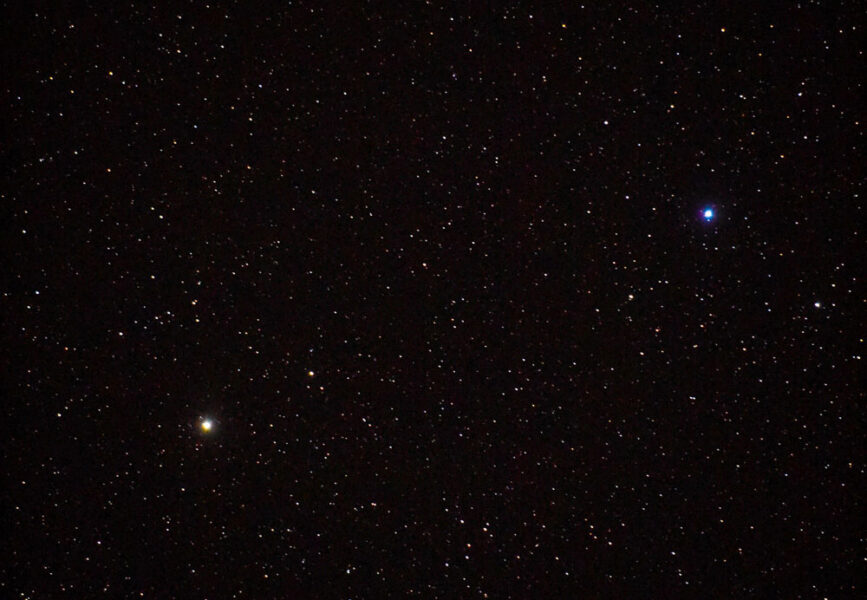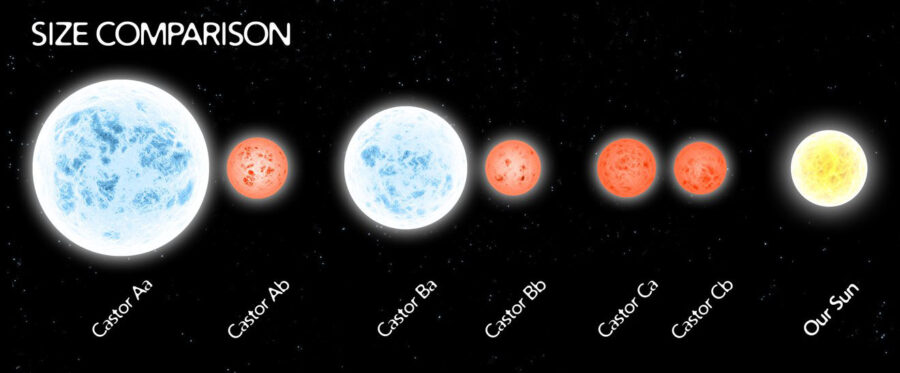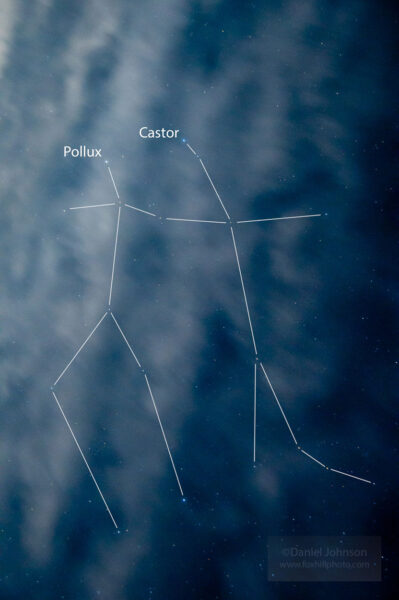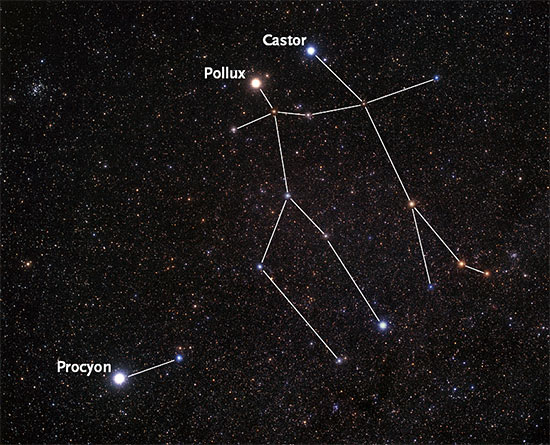Castor System Vitals
| Official name (IAU-approved) | Castor |
| Other designations | Alpha Geminorum, HIP 36850, HD 60178, HR 2890 |
| Nicknames | - |
| Apparent Magnitude | 1.58 |
| Distance from Earth | 50.9 light-years |
| Constellation | Gemini |
| Right Ascension | 7h 34m 36s |
| Declination | +31° 53' 18” |
| Multiple system? | Yes |
| Variable star? | No |
| Exoplanets status | None known |
Physical Characteristics

Daniel Johnson
Castor, a prime ornament of the Gemini constellation and one of the brightest stars in the sky, is actually a system of stars with six unique members. While the Sun is a lone star without any nearby stellar companions, it’s not uncommon to find double, triple, and even multi-star systems scattered across the galaxy. But for the majority of human history, people have looked up to the gentle blue light of Castor without knowing that they weren’t seeing just one star, or two, or three, but six individual objects. It would take two important inventions to unravel the true story of Castor: the telescope in the early 1600s and — perhaps more importantly — the spectroscope in 1859.
If you examine Castor with a small telescope — as astronomer James Pound did in 1719 — you’ll see that the star visually splits into two main luminous points. These two stars are Castor Aa and Ba, a pair of A-type main sequencestars. This result isn’t a line-of-sight effect — Castor Aa and Ba are true binary stars close to each other, orbiting a shared gravity field as first described by William Herschel in 1803. Castor Aa and Ba are both a bit larger than the Sun; Castor Aa has a little over two solar masses. Their joint orbital period is about 467 years, so don’t expect to see changes in their positions night by night the way you might with an asteroid or planet.
But there’s literally more here than meets the eye — as revealed by a spectroscope. A spectroscope divides light into individual wavelengths, in the same way that water droplets make rainbows. These spectra provide information about distant objects, such as whether they’re moving away from or towards Earth. In this way, the data can show the presence of spectroscopic binary stars — stars orbiting each other so closely that telescopes can’t resolve them, but spectroscopes detect the individual velocity components of the two stars. In the case of Castor Aa and Ba, both objects are also spectroscopic binaries, each with an M-class star (named Castor Ab and Bb), making for a total of four stars so far.
Wait though — there’s one more piece of the puzzle. Also orbiting the Castor AB system itself is a third pair of spectroscopic binaries jointly called Castor C (or YY Gem), made up of two M-class red dwarf stars named Ca and Cb. The Castor C pair is something of a renegade, orbiting the AB system on a long, elliptical orbit (not unlike Pluto in our solar system) with a period in excess of 10,000 years.
So all in all, the system is made up of three spectroscopic binaries, for a total of six stars:

NASA / JPL
| Castor A | Castor B | Castor C |
| Castor Aa A-class main sequence 2.15 solar masses | Castor Ba A-class main sequence 1.7 solar masses | Castor Ca M-class main sequence ~0.5 solar masses |
| Castor Ab M-class main sequence ~0.5 solar masses | Castor Bb M-class main sequence ~0.5 solar masses | Castor Cb M-class main sequence ~0.5 solar masses |
There may not be any immense giants in the group, but it’s an interesting and somewhat uncommon collection — almost like a mini star-cluster.
Origin / Mythology
Because Castor appears to be just one star when viewed without instruments, that’s how ancient stargazers knew it. It also appears fairly close in the sky to another star: Pollux. You can’t blame the ancients for thinking of Castor and Pollux as something of “twin” stars. The two objects are close together in the sky and roughly the same brightness, without any other bright stars in the vicinity competing for attention.
But the two are actually quite different. Pollux is a single orangish-red giant star about 34 light-years away. And despite their apparent visual proximity from our perspective, the two “twins” are in reality nowhere near each other in space.
No matter. For the sake of casual observing, Castor and Pollux make a fine set of twins; and the concept has been around for literally ages. Multiple ancient cultures shared the idea that the two stars were twins or close companions. We get our modern names Pollux and Castor from the ancient Greeks, who weaved a series of tales about the best-friend brothers, and the two stars feature as twins for Babylonia as well. In China, they represent the opposing natural forces of yin and yang, while cultures in India and North America thought of the two stars as a married couple.

Daniel Johnson
Thanks to its position on the ecliptic, Castor’s home, the constellation Gemini, is pretty well known as a zodiac constellation. In fact, Project Gemini was the name of a NASA program in the mid-1960s that launched a series of small two-seated spacecraft. You’ll find many non-astronomers who are familiar with the name, but who may not necessarily know where it is in the sky!
How to See Castor
Winter is an excellent time to see Castor, when Gemini rises fairly high in the eastern sky early in the evening, chasing Orion and Taurus. Later in the night (or on early spring evenings), you will find the constellation working its way south.
The Moon makes a monthly visit to the region, and planets sometimes frequent this constellation, since it lies in the ecliptic, which aligns with the solar system’s plane. Eventually, the Sun slides into the area, riding through Gemini around July making the constellation obviously impossible to view in the summer months.

Akira Fujii
Pollux and Castor represent the heads of the two twin figures, with Castor being the one on the right if you’re viewing the pair in an “upright” position. Along with Orion and the Big Dipper, Gemini is one of the best representative star patterns, in that it actually looks like what it’s supposed to be. Why not look for it tonight — and bring your telescope to see if you can split Castor Aa and Ba for yourself, just as James Pound did more than 300 years ago.
 2
2









Comments
Paul Starman Curnow
February 6, 2021 at 7:45 pm
Daniel thank you for a very well written article on Castor. As a matter of interest, these stars are seen as two hunters named Wanjel (Pollux) & Yurree (Castor) by the Boorong Aboriginal people of north western Victoria, Australia. I was the consultant on Aboriginal Astronomy (I am non Aboriginal) for the Australian Space Agency, and as a result these stars now appear on the logo of the Australian Space Agency. Best regards from Adelaide, South Australia Paul
You must be logged in to post a comment.
Dobsonite
February 10, 2021 at 1:34 am
Vert well done! Wish I had known this 20 years ago when I was conducting star parties for "Utes" (grade 5, 6) who hadn't invented sex yet, and were still interested in Astronomy. 😉
After grade 7, it was hopeless..
Again, fine article, good show!
You must be logged in to post a comment.
You must be logged in to post a comment.